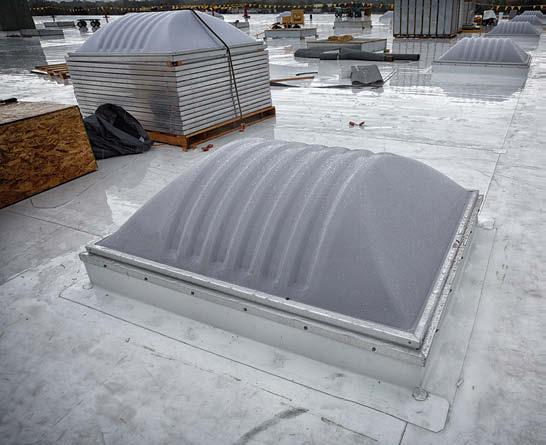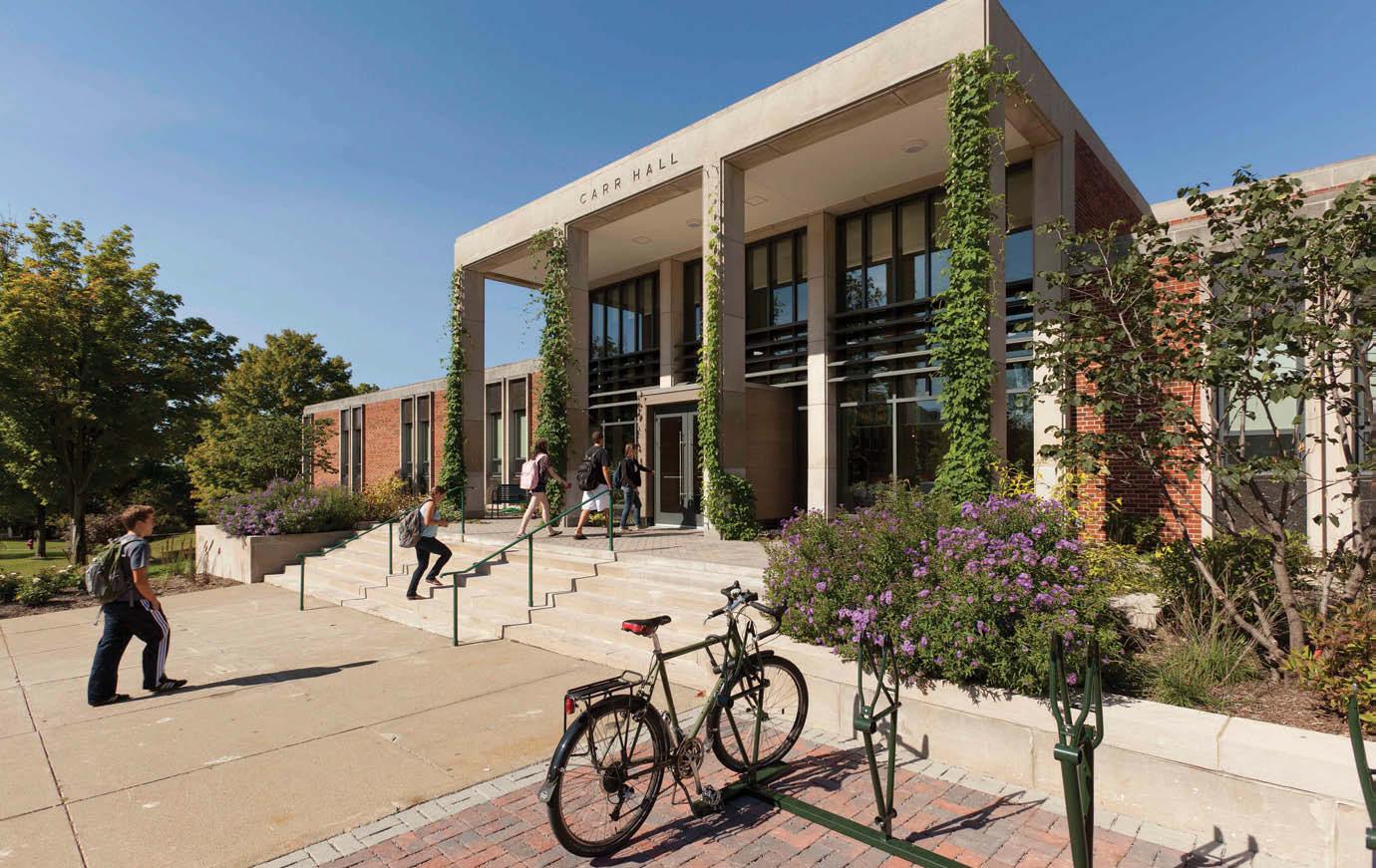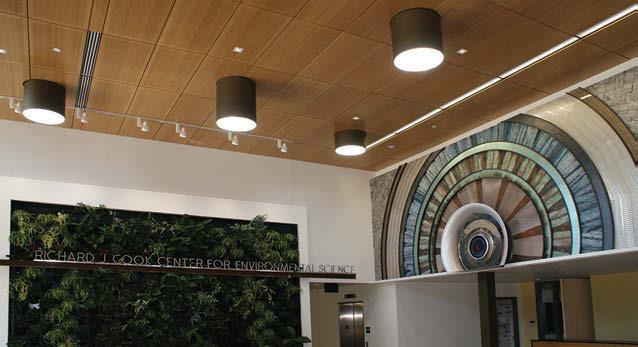
7 minute read
Skylights Enlighten Manufacturing Facility
from commARCH - June 2014
by IdeaSoil
Daylighting increases light quality and reduces energy load for a Chicago-area plant.

Advertisement
Top. Skylight installation dramatically improved light levels in the Electri-Flex building. The ceiling height is approximately 40 ft.
Above. Sunoptics skylights diffuse incoming light through prismatic lenses, eliminating hot spots, glare, or haze, as well as dissipating any heat. E lectri-Flex Co., Roselle, IL, deals in electrical conduit design and manufacturing. A new plant for the company would represent as much as a 60% increase in production and create 25 new jobs. Before expanding its manufacturing operations into a 53,000-sq.-ft. space, company brass had big plans for the existing 14-yr.-old building.
They wanted the building reclassified from industrial to heavy manufacturing and also wanted it to be as environmentally sound as possible. That meant improved energy efficiency where it was most achievable: in the building’s thermal properties and its lighting system. The owners wanted green roofing solutions, lowered indoor temperatures, and improved energy efficiency, with daylighting solutions as part of the plan.
Previously, in another building, the company retrofitted 15 skylights with new models from Sunoptics, a
Sacramento, CA, division of Acuity Brands, Atlanta, which specializes in high-performance prismatic skylights. Having seen the enhanced performance of the skylights, Electri-Flex project manager Ed Berbeka opted for them again.
A crew from CentiMark Corp., West Chicago, IL, installed 56 Sunoptics’ Signature series skylights in the
Roselle facility at the same time it replaced the insulation and installed new roofing. The insulation upgrade used R-25 material to meet international standards for long-term, thermal-resistance values. The roofing upgrade replaced the existing EPDM black rubber membrane with reflective white TPO.
“Electri-Flex knew once they bought this building what they wanted to do,” said Tim Tighe, senior project manager for CentiMark Corp. “The game plan was to do what was best for that building.” New electrical and energy-efficient electric lighting was also part of the upgrade.
NOT STANDARD LIGHTING After the roof renovation, it was estimated that the interior temperature of the building decreased by 30 deg. Lighting also improved signifi cantly. The new skylights cover 3% of the roof area, a relatively standard coverage for industrial buildings, but their prismatic properties provide anything but standard lighting. The building has a ceiling height of about 40 ft. Generally, warehouse lighting varies from as few as 5 to 10 footcandles in inactive storage areas, to as much as 30 to 40 in more active spaces such as loading docks or receiving areas. After the installation of the skylights, light-level readings in the building reached from 55 to as much as 62 footcandles without any use of electrical lighting.
“I was amazed at how much light comes into the building,” Tighe said. “The electrician had all the lights off and it was still light in there.” He also took note of the lack of hot spots created by typical bubble-dome skylights, that allow heat to build in the space below. The Sunoptics products, however, diffuse the incoming light through prismatic lenses, eliminating hot spots, glare, or haze, as well as dissipating any heat. All that remains in the space is fully captured, evenly distributed, and UV-stable daylighting coverage.
Said Sunoptics sales manager Brian Grohe, “Our skylights deliver a high-quality, naturally lit environment for the maximum amount of hours each day, and when combined with the lighting and control upgrades, allows significant reduction of electrical energy consumption.”
“We were going for the ‘wow’ factor with the skylights and resulting interior light,” said Berbeka. “We were just amazed at how much light comes into the building after we turned all of the lights off.” In addition to increasing the interior light source and providing increased energy savings, the daylighting solution also boosted employee morale in the manufacturing plant.
CBP
DATA CACHE
Want more information? The resources below are linked in our digital magazine at cbpmagazine.com/digital/jun2014.
Circle 6 on the Reader Service Card.
Download a spec sheet on the Signature series skylight.
Watch a video of the Sunoptics’ manufacturing process.

Allegheny College created the Richard J. Cook Center for Environmental Sciences in the newly renovated Carr Hall, a building constructed in the 1960s.
Tubes Deliver Daylight, Help Cut Energy By 23%
Solatube daylighting technology helps Allegheny College meet ACUPCC and LEED Gold specs.
Richard Cook is as passionate about science education and a sustainable economic and environmental future as he is about Allegheny College, where he served as president from 1996 to 2008. He was one of the early signatories of the
American College and University Presidents’ Climate
Commitment (ACUPCC), a national challenge to universities and colleges to develop a comprehensive action plan to reduce greenhouse gases by becoming more energy and materials efficient.
As a nod to his forward-thinking approach, Allegheny
College in Meadville, PA, created the Richard J. Cook
Center for Environmental Sciences at the newly renovated Carr Hall, a building constructed in the 1960s.
The lobby is not only aesthetically stunning, but a testament to sustainability. It features a working model of an aquaponics system (cultivating plants and aquatic animals for food production in a recirculating environment) with spider plants and goldfish in interconnected tanks. A living wall incorporates a variety of plants, which are irrigated by a rainwater catchment system that drains from the roof.
One of the most spectacular features is the ample use of daylight. Numerous daylighting systems from Solatube International Inc., Vista, CA, flood the lobby with natural light, eliminating the need for electric lighting during daylight hours.
Daylighting studies (such as one from Heschong Mahone Group, Gold River, CA) have shown that students perform better in the presence of daylight; absenteeism is lower; and overall attitude and morale are higher.
“We've been extremely pleased with the inclusion of a large number of daylighting systems throughout the Richard J. Cook Center for Environmental Science renovation. It is one of the features that most excites visitors and those that study and work in the building —first, because they're so surprised to hear that daylight, rather than artificial light, is illuminating the space and, second, because it adds to the warm, natural quality of the space,” said Kelly Boulton, sustainability coordinator at Allegheny College.
Additionally, tilapia and lettuce are cultivated in a large-scale aquaponics system in a lab classroom to provide food in the college’s dining room.
“We used Solatube daylighting systems in the lob

Stella™ PANEL ©2014 modularArts, Inc.
High Quality, Glass Reinforced Gypsum Panels with steel-reinforced joints precisely interlock for seamless wall surfaces of any size.
Lily™ BLOCK ©2010 modularArts, Inc. U.S. Patent 8,375,665


Sculptural screen wall blocks stack up to create fully dimensional, double-sided, rock walls. The block is back!
Now with 50 designs.


Above, top. Visitors are surprised to hear that daylight, rather than artificial light, is illuminating classrooms and labs and are pleased by the warm, natural quality of the space.
Above, bottom. The most striking daylighting application is in the lobby area, which is also home to a working aquaponics system. Custom black sleeves were designed to fit over the Solatube tubing to create a striking visual against the wood ceiling.
by and in all classrooms and labs, which has allowed us to reduce our electricity consumption while maintaining plenty of light,” Boulton said. “Not only have the units contributed to the renovation's LEED Gold certification, but they've helped us in our efforts to achieve 20% more energy efficiency in our partnership with the Department of Energy's (DOE), Washington, Better Buildings Challenge as well as move closer to our goal of climate neutrality by 2020, in partnership with the American College and University Presidents' Climate Commitment.”
The renovation team included Perfido Weiskopf Wagstaff + Goettl, Pittsburgh, architect; Massaro Corp., Pittsburgh, contractor; and Marti Laudato of M&M Specialty Products, DuBois, PA, as supplier and installer of the daylighting systems. According to Laudato, the project was really driven by the university and its architecture firm.
“When the college came to us for this renovation, they communicated two main goals: The integration of sustainability and green elements into the project, and the ability to achieve LEED certification,” said Lisa Carver, AIA, LEED AP, and associate at Perfido Weiskopf Wagstaff + Goettel. “When we started, there was artificial









